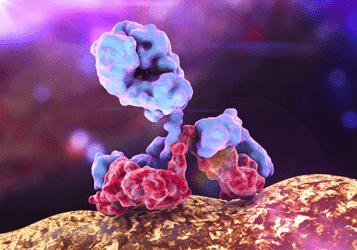- Home
- Products
- Customized ADCs
- RhD
- Anti-RhD (Morolimumab)-SMCC-DM1 ADC
Anti-RhD (Morolimumab)-SMCC-DM1 ADC (CAT#: ADC-W-1724)
This ADC product is comprised of an anti-RhD monoclonal antibody conjugated via a SMCC linker to DM1. The DM1 is targeted to certain cancers by immunerecognition and delivered into cancer cells via receptor mediated endocytosis. Within the cell, DM1 binds to tubulins, interrupts microtubule dynamics, and subsequently, induces cell death.
- ADC Target
- ADC Antibody
- ADC Linker
- ADC payload drug
- Name
- RHD
- Alternative Names
- RHD; Rh blood group, D antigen; RH, Rhesus blood group, D antigen; blood group Rh(D) polypeptide; CD240D; DIIIc; Rh4; Rh30a; RhII; RhPI; D antigen (DCS); RH polypeptide 2; rhesus D antigen; Rhesus system D polypeptide; Rh blood group antigen Evans; Rhesus blood group D antigen allele DIII type 7; RH; RH30; RHCED; RHDel; RHPII; RhDCw; RHXIII; RHDVA(TT); RhK562-II; MGC165007;
- Target Entrez Gene ID
- 6007
- Target UniProt ID
- Q02161
- Overview
- The Rh blood group system is the second most clinically significant of the blood groups, second only to ABO. It is also the most polymorphic of the blood groups, with variations due to deletions, gene conversions, and missense mutations. The Rh blood group includes this gene, which encodes the RhD protein, and a second gene that encodes both the RhC and RhE antigens on a single polypeptide. The two genes, and a third unrelated gene, are found in a cluster on chromosome 1. The classification of Rh-positive and Rh-negative individuals is determined by the presence or absence of the highly immunogenic RhD protein on the surface of erythrocytes. Multiple transcript variants encoding different isoforms have been found for this gene.
- Overview
- Human Anti-RhD IgG1 antibody, Morolimumab
- Generic name
- Morolimumab
- Host animal
- Human
- Name
- SMCC (N-succinimidyl 4-(Nmaleimidomethyl)cyclohexane-1-carboxylate)
- Description
- Disulfide Linkers, are extensively exploited as a chemically labile linkage. Since the release of disulfide-linked drugs requires a cytoplasmic thiol cofactor, such as glutathione (GSH). Disulfides maintain stable at physiological pH and only when ADCs are internalized inside cells, the cytosol provides reducing environment including intracellular enzyme protein disulfide isomerase, or similar enzymes, drugs can be released.
- Name
- DM1 (N2'-Deacetyl-N2'-(3-mercapto-1-oxopropyl)maytansine)
- Description
- Derived from Maytansinoid,a group of cytotoxins structurally similar to rifamycin, geldanamycin, and ansatrienin. The eponymous natural cytotoxic agent maytansine is a 19-member lactam (ansa macrolide) structure originally isolated from the Ethiopian shrub Maytenus ovatus. Maytansinoids can bind to tubulin at or near the vinblastine-binding site, which interfere the formation of microtubules and depolymerize already formed microtubules, inducing mitotic arrest in the intoxicated cells.
For Research Use Only. NOT FOR CLINICAL USE.
Related Products
- Anti-CD3E (Muromonab)-MC-Vc-PAB-SN38 ADC (CAT#: ADC-W-852)
- Anti-ERBB2 (Trastuzumab)-SPDB-DM4 ADC (CAT#: ADC-W-2595)
- Anti-TNFRSF17-VC-MMAE ADC-8 (CAT#: ADC-W-269)
- Anti-ERBB2 (Trastuzumab)-vandetanib ADC (CAT#: ADC-W-513)
- Anti-PDCD1 (Pidilizumab)-MC-Vc-PAB-SN38 ADC (CAT#: ADC-W-1704)
- Anti-TNFRSF17-VC-MMAE ADC-13 (CAT#: ADC-W-274)
- Anti-MS4A1 (Ofatumumab)-SMCC-DM1 ADC (CAT#: ADC-W-1544)
- Anti-APP (Bapineuzumab)-MC-Vc-PAB-DMEA-(PEG2)-duocarmycin SA ADC (CAT#: ADC-W-709)
- Anti-CD22-Mc-VC-PABC-MMAE ADC-9 (CAT#: ADC-W-216)
- Anti-Endotoxin (Edobacomab)-MC-Vc-PAB-DMEA-(PEG2)-duocarmycin SA ADC (CAT#: ADC-W-2191)
Published Data
+ Submit Publications

Scientific Resources
Customer Reviews and FAQs
There are currently no Customer reviews or questions for ADC-W-1724. Click the button above to contact us or submit your feedback about this product.
Quick Links
Other Products
Same Target
Same Linker
Same Payload
| CAT# | Product Name | Linker | Payload |
| ADC-W-1728 | Anti-RhD (Morolimumab)-MC-Vc-PAB-SN38 ADC | MC-Vc-PAB (maleimidocaproyl-valine-citrulline-p-aminobenzoyloxycarbonyl) | SN-38 (7-ethyl-10-hydroxycamptothecin) |
| ADC-W-1733 | Anti-RhD (Roledumab)-MC-Vc-PAB-MMAE ADC | MC-Vc-PAB (maleimidocaproyl-valine-citrulline-p-aminobenzoyloxycarbonyl) | MMAE |
| ADC-W-1722 | Anti-RhD (Atorolimumab)-MC-Vc-PAB-SN38 ADC | MC-Vc-PAB (maleimidocaproyl-valine-citrulline-p-aminobenzoyloxycarbonyl) | SN-38 (7-ethyl-10-hydroxycamptothecin) |
| ADC-W-1721 | Anti-RhD (Atorolimumab)-MC-Vc-PAB-MMAE ADC | MC-Vc-PAB (maleimidocaproyl-valine-citrulline-p-aminobenzoyloxycarbonyl) | MMAE |
| ADC-W-1725 | Anti-RhD (Morolimumab)-SPDB-DM4 ADC | SPDB (N-succinimidyl-4-(2-pyridyldithio)butyrate) | DM4 (N2'-Deacetyl-N2'-(4-mercapto-4-methyl-1-oxopentyl)maytansine) |
| CAT# | Product Name | Linker | Payload |
| ADC-W-603 | Anti-FOLH1-SMCC-DM1 ADC-3 | SMCC (N-succinimidyl 4-(Nmaleimidomethyl)cyclohexane-1-carboxylate) | DM1 (N2’-Deacetyl-N2’-(3-mercapto-1-oxopropyl)maytansine) |
| ADC-W-479 | Anti-CD74-SMCC-Dox ADC | SMCC (N-succinimidyl 4-(Nmaleimidomethyl)cyclohexane-1-carboxylate) | Doxorubicin |
| ADC-W-2604 | Anti-ITGB3 (Tadocizumab)-SMCC-DM1 ADC | SMCC (N-succinimidyl 4-(Nmaleimidomethyl)cyclohexane-1-carboxylate) | DM1 (N2'-Deacetyl-N2'-(3-mercapto-1-oxopropyl)maytansine) |
| ADC-W-504 | Anti-EGFR (cetuximab)-SMCC-Doxorubicin ADC | SMCC (N-succinimidyl 4-(Nmaleimidomethyl)cyclohexane-1-carboxylate) | Doxorubicin |
| ADC-W-2620 | Anti-NCAM1 (Lorvotuzumab )-SMCC-DM1 ADC | SMCC (N-succinimidyl 4-(Nmaleimidomethyl)cyclohexane-1-carboxylate) | DM1 (N2'-Deacetyl-N2'-(3-mercapto-1-oxopropyl)maytansine) |
| CAT# | Product Name | Linker | Payload |
| ADC-W-2565 | Anti-MUC16 (Sofituzumab)-SMCC-DM1 ADC | SMCC (N-succinimidyl 4-(Nmaleimidomethyl)cyclohexane-1-carboxylate) | DM1 (N2'-Deacetyl-N2'-(3-mercapto-1-oxopropyl)maytansine) |
| ADC-W-2532 | Anti-CD22 (Pinatuzumab)-SMCC-DM1 ADC | SMCC (N-succinimidyl 4-(Nmaleimidomethyl)cyclohexane-1-carboxylate) | DM1 (N2'-Deacetyl-N2'-(3-mercapto-1-oxopropyl)maytansine) |
| ADC-W-2548 | Anti-CD74-SMCC-DM1 ADC | SMCC (N-succinimidyl 4-(Nmaleimidomethyl)cyclohexane-1-carboxylate) | DM1 (N2'-Deacetyl-N2'-(3-mercapto-1-oxopropyl)maytansine) |
| ADC-W-2571 | Anti-SLC34A2 (Lifastuzumab )-SMCC-DM1 ADC | SMCC (N-succinimidyl 4-(Nmaleimidomethyl)cyclohexane-1-carboxylate) | DM1 (N2'-Deacetyl-N2'-(3-mercapto-1-oxopropyl)maytansine) |
| ADC-W-2554 | Anti-CD79B (Polatuzumab )-SMCC-DM1 ADC | SMCC (N-succinimidyl 4-(Nmaleimidomethyl)cyclohexane-1-carboxylate) | DM1 (N2'-Deacetyl-N2'-(3-mercapto-1-oxopropyl)maytansine) |
Online Inquiry
Welcome! For price inquiries, please feel free to contact us through the form on the left side. We will get back to you as soon as possible.



